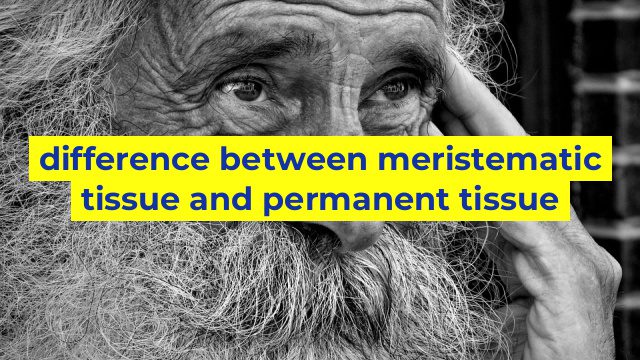Understanding the Difference between Meristematic Tissue and Permanent Tissue
Plant tissues are classified into two main categories: meristematic tissue and permanent tissue. These two types of plant tissues are very different in terms of their structure, function, and characteristics. In this article, we will explore the differences between meristematic tissue and permanent tissue.
What is Meristematic Tissue?
Meristematic tissue is the primary tissue that is responsible for the growth and development of the plant. It contains cells that are undifferentiated, which means that they have not yet been specialized into specific types of cells. These cells are characterized by a high rate of cell division, which is necessary for the growth of the plant.
Meristematic tissue can be found in two regions of the plant: apical meristems and lateral meristems. Apical meristems are located at the tips of stems and roots, while lateral meristems are found along the sides of stems and roots.
In apical meristems, the cells divide and differentiate to form the various structures of the plant, such as the leaves, stems, and roots. Lateral meristems, on the other hand, are responsible for the increase in girth or thickness of the plant.
What is Permanent Tissue?
Permanent tissue, as the name suggests, is the tissue that remains in the plant for its entire life cycle. It is formed from the meristematic tissue and is composed of cells that have already differentiated into specific types of cells. These cells are no longer capable of dividing and are responsible for carrying out various functions of the plant.
There are two types of permanent tissue: simple tissue and complex tissue. Simple tissue is composed of a single type of cell, while complex tissue is composed of multiple types of cells.
Simple tissue can be further classified into three types: parenchyma, collenchyma, and sclerenchyma. Parenchyma cells are involved in photosynthesis and storage of nutrients, collenchyma cells provide support to the plant, and sclerenchyma cells provide mechanical support and protection.
Complex tissue, on the other hand, is composed of multiple types of cells that work together to perform a specific function. Xylem and phloem are examples of complex tissue. Xylem is responsible for transporting water and minerals from the roots to the rest of the plant, while phloem is responsible for transporting sugars from the leaves to the rest of the plant.
The Key Differences between Meristematic Tissue and Permanent Tissue
The main difference between meristematic tissue and permanent tissue is that meristematic tissue contains undifferentiated cells that are capable of dividing, while permanent tissue contains specialized cells that are no longer capable of dividing. Meristematic tissue is responsible for the growth and development of the plant, while permanent tissue performs various functions of the plant.
Another important difference is that meristematic tissue is located at the apical and lateral meristems of the plant, while permanent tissue is found in various parts of the plant, such as the leaves, stems, and roots.
In conclusion, meristematic tissue and permanent tissue are two important types of plant tissue that play different roles in the growth and development of the plant. Understanding the differences between these two tissues can help you better understand the functioning of plants and their various parts.
Table difference between meristematic tissue and permanent tissue
| Meristematic Tissue | Permanent Tissue |
|---|---|
| 1. Found at the tips of the roots, stems, and branches, and in certain other parts of the plant body. | 1. Found throughout the plant body. |
| 2. Consists of small, densely packed cells with thin walls. | 2. Consists of larger, less densely packed cells with thicker walls. |
| 3. Cells are actively dividing and differentiating, leading to growth and development of the plant body. | 3. Cells have stopped dividing and have become specialized for specific functions such as photosynthesis, support, and storage. |
| 4. Provides a continuous supply of new cells throughout the life of the plant. | 4. Does not provide a continuous supply of new cells. |
| 5. Types include apical meristem, lateral meristem, and intercalary meristem. | 5. Types include parenchyma, collenchyma, and sclerenchyma. |


